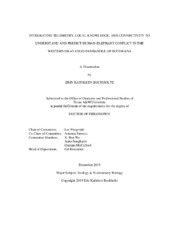| dc.description.abstract | Human-wildlife conflict is a considerable challenge for wildlife conservation. An increasing global human footprint that overlaps with wildlife population ranges may increase the opportunity for negative interactions between people and wildlife. Understanding when, where, and how these overlaps occur can provide useful insights in designing conservation strategies that reduce conflict. My dissertation is focused on the conflict between people and African savanna elephants (Loxodonta africana) in the Western Okavango Panhandle of Botswana. Crop-raiding, property damage, and injury and death caused by elephants represent a significant source of conflict for people living in this region. I used GPS collar data, local ecological knowledge, and connectivity approaches to understand how elephants used the landscape, and how that use may contribute to patterns of conflict. Through assessment of collar data and adaptive kernel density estimates, I found that elephants used areas close to human development, and in the dry season nearly 50% of core areas were located within 5km of human land-use. Moreover, elephants were closer to development more than expected during the season when crops are ripening and there are significant seasonal and diel differences to consider.
Knowledge from community-defined local experts, through participatory ranking activities, was used to parameterize an elephant resource selection function in combination with environmental data. This model had high predictive power for elephant resource use at a local scale, which complemented telemetry-based resource selection functions which were more predictive at the Panhandle scale. Lastly, I found that connectivity, based on seasonal step-selection functions and using circuit theory, was not a strong predictor of human-elephant conflict incident locations, nor did it account for how frequently fields were raided. Overall, this dissertation aims to integrate different methods to understand how elephants use the landscape and the implications of that landscape-use for human-elephant conflict. By assessing the seasonal and diel nature of elephant movements, taking advantage of local expert knowledge, and recognizing the potential disparity between landscape-scale drivers of movement and factors influencing conflict occurrence, I hope to have contributed to advancing the methods and knowledge needed for conservation efforts and reducing conflict between people and elephants. | en |


